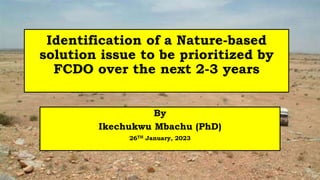DESERTIFICATION AND NATURE BASED SOLUTIONS IN NIGERIA.pptx
- 1. Identification of a Nature-based solution issue to be prioritized by FCDO over the next 2-3 years By Ikechukwu Mbachu (PhD) 26TH January, 2023
- 2. Introduction ’ü▒Nigeria grapples with a myriad of environmental issues ’āśFlooding ’āśDesertification ’āśErosion ’āśDeforestation ’ü▒Choosing a single nature-based solution (NBS) issue as the top priority is a delicate task Source: Pona, et al (2017)
- 3. Prioritization Criteria ’āśNature of Impact ’āśScope and extent ’āśUrgency ’āśCost ’āśFeasibility and Scalability ’āśAlignment with Strategic Priorities DESERTIFICATION = HIGH IMPACT NBS ISSUE IN NIGERIA
- 4. Why prioritize Desertification? ’ü▒Nature of the issues/challenge: ’āśDesertification is an ongoing and continuous hazard ’ü▒Extent of Desertification: ’āśImpacts 15 northern states (Olagunju, 2015) ’āśThese states represent 35% of Nigeria's total landmass (Punch Newspaper, 2020) ’āś1,350 square miles of land is lost to the desert each year (Caron, 2020) ’āśAffected Population: Approximately 30 million Nigerians (17% of the population) suffer the consequences of desertification (Ibrahim, et al., 2022) ’ü▒Urgency and Impact ’āśDesertification encroaches southward at an alarming rate of 0.6 km per year, engulfing around 351,000 hectares of cropland and rangeland annually (Ibrahim, et al., 2022)
- 5. ’ü▒Cost ’āśDesertification costs Nigeria an estimated $5.1 billion annually in lost agricultural productivity (Oloukoi, Gbenga, & Langyit, 2018). ’āśAgricultural and Livelihoods Loss: Over 40 million people in desert-affected areas threatened by desertification (Isaac, 2017). ’ü▒Alignment with NDC ’āśCombating desertification aligns with Nigeria's NDC and its commitment to sustainable land management. Why prioritize Desertification?
- 6. How: Proposed Prioritization Strategies ’ü▒Scale-up successful NBS ’āśIdentify existing successful NBS projects in Nigeria ’ü▒Leverage with existing programs ’āśAlign desertification initiatives with existing programs ’ü▒Building capacity and networks ’āśPrioritize training and knowledge exchange programs for NGOs, communities etc ’ü▒Focus on equity and inclusivity ’āśEnsure that NbS benefits reach marginalized communities. ’ü▒Incentivizing sustainable land use ’āśImplement financial incentives such as subsidies or carbon credits.
- 7. How: Actionable Steps Step 1 ŌĆó Clearly define the objectives and goals for addressing desertification in Nigeria. ŌĆó Conduct a comprehensive needs assessment to identify priority areas for intervention and potential NBS solutions. ŌĆó Launch pilot projects for promising NBS technologies in collaboration with local partners. ŌĆó Develop and implement robust M&E systems for all NBS projects. ŌĆó Conduct training workshops and capacity building programs for communities. ŌĆó Initiate policy dialogue with the Nigerian government to identify key policy reforms. Step 2: ŌĆó Scale up successful pilot projects based on M&E data and lessons learned. ŌĆó Advocate for policy reforms through workshops, conferences, and engagement with decision-makers. Step 3: ŌĆó Showcase the success of NBS interventions to attract further investment and support.
- 8. Conclusion ’āśIn summary, combating desertification aligns strategically with FCDO's objectives by promoting sustainable development, building resilience, supporting economic growth, fostering collaboration, and directly contributing to the priorities outlined in Nigeria's NDC. ’āśThis alignment underscores the effectiveness and relevance of FCDO's interventions in addressing critical environmental challenges.
- 9. References ŌĆó Caron, L. (2020). The Threat Multiplier: Analyzing the Relationship between Climate Change and the Emergence of. Harvard University Division of Continuing Education. Retrieved from https://dash.harvard.edu/bitstream/handle/1/37367511/Caron%2C%20Louis-Philippe_2020-Nov.pdf?sequence=1&isAllowed=y ŌĆó Ibrahim, E. S., Ahmed, B., Arodudu, O. T., Abubakar , J. B., Dang, B. A., Mahmoud, M. I., . . . Shamaki, S. B. (2022). Desertification in the Sahel Region: A Product of Climate Change or Human Activities? A Case of Desert Encroachment Monitoring in North-Eastern Nigeria Using Remote Sensing Techniques. Geographies, 2(2), 204-226. Retrieved from https://doi.org/10.3390/geographies2020015 ŌĆó Isaac, N. (2017). WDDD: Over 40M Nigerians Affected By Desertification ŌĆō Mahmood. Newspaper. ScienceNigeria. Retrieved from https://sciencenigeria.com/wddd-over-40m-nigerians-affected-by-desertification-mahmood/ ŌĆó Olagunju, T. E. (2015). Drought, desertification and the Nigerian environment:A review. Journal of Ecology and the Natural Environment, 7(7), 196-209. Retrieved from https://academicjournals.org/journal/JENE/article-abstract/4505E2154369 ŌĆó Oloukoi, J., Gbenga, A. E., & Langyit, D. G. (2018). Desertification risk analysis and assessment in Northern Nigeria. Remote Sensing Applications: Society and Environment, 11, 70-82. Retrieved from https://www.sciencedirect.com/science/article/abs/pii/S2352938517300629#:~:text=It%20has%20been%20estimated%20that%2 0between%2050%25%20and%2075%25%20of,desertification%20(Kabara%2C%202013). ŌĆó Pona, H. T., Xiaoli, D., Ayantobo, O. O., & Tetteh, N. D. (2017). Environmental health situation in Nigeria: current status and future needs. Heliyon, 7. Retrieved from https://linkinghub.elsevier.com/retrieve/pii/S2405844021004357 ŌĆó Punch Newspaper. (2020). 35% Nigeria land mass threatened by desertification ŌĆōFG. Punch Newspaper. Retrieved from https://punchng.com/35-nigeria-land-mass-threatened-by-desertification-fg/










